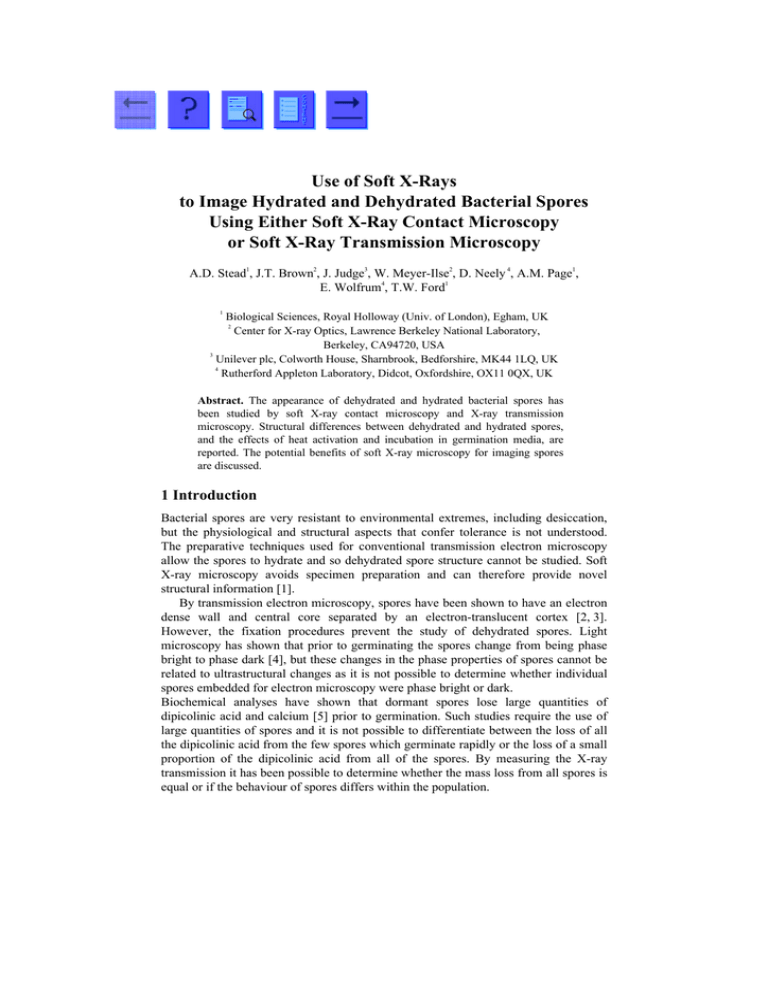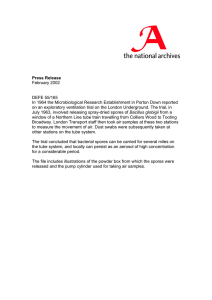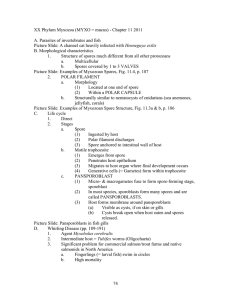Use of Soft X-Rays to Image Hydrated and Dehydrated Bacterial Spores
advertisement

Use of Soft X-Rays to Image Hydrated and Dehydrated Bacterial Spores Using Either Soft X-Ray Contact Microscopy or Soft X-Ray Transmission Microscopy 1 2 3 2 4 1 A.D. Stead , J.T. Brown , J. Judge , W. Meyer-Ilse , D. Neely , A.M. Page , 4 1 E. Wolfrum , T.W. Ford 1 Biological Sciences, Royal Holloway (Univ. of London), Egham, UK 2 Center for X-ray Optics, Lawrence Berkeley National Laboratory, Berkeley, CA94720, USA 3 Unilever plc, Colworth House, Sharnbrook, Bedforshire, MK44 1LQ, UK 4 Rutherford Appleton Laboratory, Didcot, Oxfordshire, OX11 0QX, UK Abstract. The appearance of dehydrated and hydrated bacterial spores has been studied by soft X-ray contact microscopy and X-ray transmission microscopy. Structural differences between dehydrated and hydrated spores, and the effects of heat activation and incubation in germination media, are reported. The potential benefits of soft X-ray microscopy for imaging spores are discussed. 1 Introduction Bacterial spores are very resistant to environmental extremes, including desiccation, but the physiological and structural aspects that confer tolerance is not understood. The preparative techniques used for conventional transmission electron microscopy allow the spores to hydrate and so dehydrated spore structure cannot be studied. Soft X-ray microscopy avoids specimen preparation and can therefore provide novel structural information [1]. By transmission electron microscopy, spores have been shown to have an electron dense wall and central core separated by an electron-translucent cortex [2, 3]. However, the fixation procedures prevent the study of dehydrated spores. Light microscopy has shown that prior to germinating the spores change from being phase bright to phase dark [4], but these changes in the phase properties of spores cannot be related to ultrastructural changes as it is not possible to determine whether individual spores embedded for electron microscopy were phase bright or dark. Biochemical analyses have shown that dormant spores lose large quantities of dipicolinic acid and calcium [5] prior to germination. Such studies require the use of large quantities of spores and it is not possible to differentiate between the loss of all the dipicolinic acid from the few spores which germinate rapidly or the loss of a small proportion of the dipicolinic acid from all of the spores. By measuring the X-ray transmission it has been possible to determine whether the mass loss from all spores is equal or if the behaviour of spores differs within the population. II - 158 A. D. Stead et al. 2 Material and Methods Bacterial spores (Bacillus subtilis) were prepared [4] and transported frozen. After thawing the spores were aliquoted and refrozen; each experiment used a fresh aliquot. Initial experiments compared the structure of hydrated spores to dehydrated spores O and in subsequent experiments spores were activated (70 C for 30min; phosphatecitrate buffer (50mM, pH 7.0)) followed by resuspension in nutrient broth (Oxoid) o with 10mM L-alanine added and incubated at 30 C. Before, or at various times after, addition of germination media a 2 l sample was removed and imaged. 2.1 Soft X-Ray Contact Microscopy Spores were mounted on a photoresist (0.9 m thick polymethyl-methacrylate) in an environmental cell [6]. The specimen was protected from the vacuum by a 120nm thick Si3N4 window (aperture 250x250µm; FaSTec, UK) [7]. Using a rapid feedthrough interlock, specimens could be imaged within 3-5mins. Soft X-rays were generated from a yttrium target using up to 15J laser energy (1.053µm; 1-3nsec pulse) generated from a Nd:glass laser (Rutherford Appleton Lab., UK). The exposed photoresist was developed with mixtures of methyl isobutyl ketone (MIBK) and isopropyl alcohol (IPA) to reveal a topographical map of the soft X-ray absorbance by the original specimen [6]. Development depth was monitored by interference light microscopy (Leitz Dialux) and then the developed photoresist was viewed by atomic force microscopy (Topometrix or Park Scientific). 2.2 Transmission X-Ray Microscopy 2µl of the spore suspension was placed between two 120nm thick Si3N4 windows. The preparation was examined by phase contrast light microscopy and fields of view selected which included phase bright, phase dark and, if possible, vegetative cells. Each field of view was photographed for comparison with the X-ray images. The field co-ordinates were recorded and imaged spores with soft X-rays using XM-1 on beamline 6.1 at the ALS, Berkeley, USA [8] using monochromatic soft X-rays (2.4 nm). 3 Results and Discussion 3.1 Soft X-Ray Contact Microscopy Very little soft X-ray flux penetrates the dehydrated spores and when the photoresist is developed the background develops away leaving a very strong image of the dry spore. The images are very smooth, indicating that the soft X-ray absorbing properties of the spore are very uniform across the spore (Fig. 1a). This ability to absorb the soft X-rays is due to the carbon content of the spore and therefore shows that the carbon density of the spore is high, furthermore it is distributed very homogeneously within the dehydrated spore. In contrast, the carbon density of the wet (but not activated) spore is very heterogenous as the images, whilst still very strong (ie the spores are still very carbon-dense) are very uneven (Fig. 1b). This implies that the ability to absorb Use of Soft X-Rays to Image Hydrated and Dehydrated Bacterial Spores II - 159 soft X-rays is not uniform and this reflects the non-uniform carbon distribution within the spore. In some spores the cental core is a prominent feature (Fig. 1c) indicating that this region has greater X-ray density. The cell wall of the spores could not be differentiated from the rest of the spore. Fig. 1. Atomic force image of the developed photoresist produced by soft X-ray contact microscopy. a) dehydrated; b-c) hydrated (but not activated). 3.2 Transmission X-Ray Microscopy The hydrated spores have an X-ray dense core and an X-ray dense wall but the region between is relatively X-ray transparent. This area corresponds to the cortex, as seen by electron microscopy, where it is electron translucent [2,3]. Since soft X-rays (2.4nm) and electrons are transmitted through this region of the spore it is clear that the carbon-containing density of this region must be very different to that of the core. The difference in X-ray absorption is exaggerated by repeated exposure of the spores, indicating that the spores are radiation-sensitive (Fig. 2a-b), great care is therefore needed in the interpretation of the images and in particular the existence of the X-ray dense wall needed to be confirmed. To achieve this the thickness of the wall was measured and then the pixels combined such that the resolution was not reduced below that of the wall thickness, by doing this the exposures times could be reduced to a time in which radiation damage was considered unlikely. In a exposure of 1sec with 6x6 binning it was still possible to distinguish the X-ray dense wall and core and the X-ray lucent area between these (Fig. 2a). In this image the number of transmitted photons per pixel element was 12908 ± 495 in the central X-ray dense core but 14625 ± 793 in the cortex area. There was therefore a reduction of photons of about 12% in the core area as compared to the cortex. Dehydrated spores were exposed for shorter times to ensure that the radiation doses were similar to those given to hydrated spores, thus an exposure of 0.8sec was equivalent to 5sec and 5sec was equivalent to 30sec. In both cases the spores appeared uniformly X-ray dense with no indication of an X-ray lucent cortex (Fig. 2c). Extremely long exposures also show no indication of radiation damage (Fig. 2d). The 7 radiation dose received by the specimen during such a long exposure was 1.9 x 10 Gy which is considerably higher than that reported to cause functional or structural damage in other biological tissue [9-12]. II - 160 A. D. Stead et al. Fig. 2. Soft X-ray transmission images of hydrated spores (a-b) and dehydrated spores (c-d). a) 1 sec exposure with 6x6 pixel binning; b) 10sec exposure (1sec previous exposure) with 6x6 pixel binning. c) 5sec exposure, no binning; d) 150sec exposure, no binning. These images are therefore similar to those obtained by contact microscopy and show that spores have an X-ray translucent cortex with an X-ray dense core, furthermore the wall was distinguishable due its greater X-ray absorbance. As with contact microscopy the dehydrated spore was found to be uniformly X-ray dense. Whilst the hydrated spores appear to be radiation-sensitive the dehydrated spores appear to be structurally unaffected by exposure to high doses of soft X-rays. Spore structure after activation and during germination was studied by monitoring which spores were phase bright or phase dark prior to soft X-ray imaging. Short exposures, ie with a minimum radiation dose, showed no suggestion of an X-ray translucent cortex in activated spores. In subsequent exposures the X-ray dense core and wall were clearly separated by a less X-ray dense cortex (Fig. 3a-c). This is in contrast to the images of hydrated, but not activated spores, in which the X-ray lucent cortex was seen in even the shortest of exposures and suggests that there are fundamental structural differences between hydrated and activated spores. Radiation damage, caused by prolonged exposure to X-rays was demonstrated by quantifying soft X-ray transmission or measuring the linear dimensions of the spores (Fig. 4a,b). Phase bright and phase dark spores, as well as vegetative cells, were subject to radiation damage (Fig. 5) when imaged sequentially. Such mass loss during exposure to soft X-rays is similar to that reported for isolated chromosomes [9] and once again demonstrates the need for caution when interpreting soft X-ray images of hydrated biological material which have required prolonged exposure times. The most striking difference between phase bright and phase dark spores is their X-ray transmission characteristics; phase bright spores are X-ray dense but phase dark spores are more X-ray translucent (Fig. 3, 5). Quantitative analysis shows a c.40% loss of material from the phase dark spores relative to the phase bright spores with no change in the spore size. Vegetative cells absorb an even lower proportion of the incident radiation and, on a per area basis, there is a c.80% loss of material relative to phase bright spores, however the vegetative cells are considerably larger than the spores and the loss of material must, in part, reflect a dilution of the X-ray absorbing materials. It is not known if the reduced X-ray absorbance is due to the loss of calcium Use of Soft X-Rays to Image Hydrated and Dehydrated Bacterial Spores II - 161 dipicolinate but biochemical analyses shows that over 600nM of dipicolinate is lost per mg of spores within 15min of adding germination media [5]. Previous attempts at soft X-ray contact microscopy at the N or CaIII edge showed that the spores were rich in calcium but failed to detect the distribution of calcium [3] within the spore. However, because of the long exposure times needed, the material was dry and as the present study has shown X-ry absorbing properties of dehydrated spores is very uniform. With the benefit of third generation high brightness synchrotron sources and modern CCD cameras it should be possible to gain further data on the distribution of calcium within the spore and the loss of calcium as the spore is activated and eventually germinates. Fig. 3. Sequential images of phase bright (B) and phase dark spores (a-c) Fig. 4. a) Spore (open symbols) or vegetative cell (closed symbols) size reduction caused by successive exposures. b) Mass loss from spores after sequential imaging with soft X-rays. One of the advantages of studies using XM-1 at the ALS for soft X-ray transmission microscopy is the ability to determine which spores are phase bright or phase dark immediately prior to imaging with soft X-rays. In previous studies using either electron microscopy or biochemical techniques populations of spores are II - 162 A. D. Stead et al. studied and the physiological state of individual spores is unknown. Studies have shown that the behaviour of spores within a population can be very variable [4] or even biphasic [13] and this complicates data interpretation. By determining which spores are phase bright and phase dark prior to imaging, soft X-ray microscopy can contribute more information about the timing of the loss of material relative to the shift in phase properties and the time of germination. Fig. 5. Quantification of the soft X-ray absorbance by phase bright, phase dark and vegetative cells and the effect of subsequent re-exposure. In each case the thickness of carbon giving the same aborsbance has been calculated. The variation in radiation dose (due to the changing beam conditions was minimal between samples and exposures). 4 Conclusion Spores structure, as seen by soft X-ray transmission microscopy, changes as the spores hydrate, become activated and finally germinate. Long exposures affect the appearance of all but dehydrated spores. The changes can be summarised as follows: - - Dehydrated spores - are uniformly X-ray dense without any indication of an Xray lucent cortex and are extremely resistant to damage by radiation Hydrated spores - have an X-ray dense core and wall separated by an X-ray lucent cortex, radiation exaggerates these differences Activated spores (phase bright) - initially show no indication of an X-ray lucent cortex but exposure to radiation very quickly causes condensation of the core to leave an X-ray lucent cortex Activated spores (phase dark) - overall are much more X-ray lucent (equivalent to a loss of about 40% of the X-ray absorbing properties) but otherwise behave the same as the phase bright spores (ie subject to radiation damage) Use of Soft X-Rays to Image Hydrated and Dehydrated Bacterial Spores - II - 163 Vegetative cells - even more X-ray lucent than the phase dark spores (equivalent to a loss of about 80% of the X-ray absorbing properties of phase bright spores) and still very radiation sensitive although the affect of radiation is somewhat different. Acknowledgments The direct imaging work has been carried out with the "High Resolution X-ray Microscope" (XM-1) at the Advanced Light Source, build and operated by Berkeley Labs Center for X-ray Optics (CXRO) and supported by the United States Department of Energy under contract DE-AC 03-76SF00098 and the Laboratory Directed Research and Development Program (LDRD). Financial support for this work was received from Unilever plc and EPSRC (Grant refs GR/J76248 and GR/K23522). References 1 A.D. Stead, R.A. Cotton, J.A. Goode, J.G. Duckett, A.M. Page, and T.W. Ford. J. X-ray Sci. & Technol. 5, 52 (1995). 2 S. Kozuka, and K. Tochikubo. J. of Bacteriol. 156, 409 (1983). 3 B.J. Panessa-Warren, G.T. Tortora, R.L. Stears, and J.B. Warren. Ultramicrosc. 36, 277 (1991). 4 P.J. Coote, C.M-P. Billon, S. Pennell, P.J. McClure, D.P. Ferdinando, and M.B. Cole. J. of Microbiol. Methods 21, 193 (1995). 5 I.R. Scott, and D.J. Ellar. J. of Bacteriol. 135, 133 (1978). 6 T.W. Ford, A.D. Stead, and R.A. Cotton. Elec. Microsco. Rev. 4, 269 (1991). 7 P.A.F. Anastasi, and R.E. Burge, In: X-Ray Microscopy III (Eds. A.G. Michette, G.R. Morrison and C.J. Buckley). Springer. 341 (1992). 8 W. Meyer-Ilse, H. Medecki, L. Jochum, E. Anderson, D. Attwood, C. Magowan, R. Balhorn, and M. Moronne. Synchrotron Radiation News 8, 29 (1995). 9 S. Williams, X. Zhang, C. Jacobsen, J. Kirz, S. Lindaas, J. Vanthof, and S.S. Lamm. J. of Microsc. 170, 155 (1993). 10 M. Bennett, G.F. Foster, C.J. Buckley, and R.E. Burge. J. of Microsc. 172, 109 (1993). 11 T.W. Ford, A.M. Page, G.F. Foster, and A.D. Stead. SPIE Proceedings 1741, 325 (1993). 12 H. Fujisaki, S. Takahashi, H. Ohzeki, K. Sugisaki, H. Kondo, H. Nagata, H. Kato, and S. Ishiwata. J. of Microsc. 182, 79 (1996). 13 T. Hashimoto, W.R. Frieben, and S.F. Conti. J. of Bacteriol. 98, 1011 1969.





